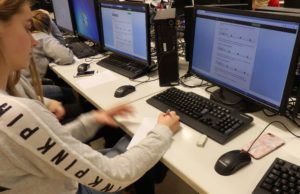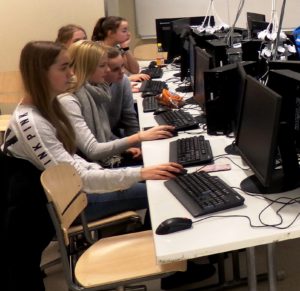During the last few years, digitalization in teaching has escalated and at the same time the discussion about the topic has also increased. However, discussions on the use of technology for teaching purposes have often had a negative tone in the media. To counterbalance this, it is necessary to bring forward the opportunities that technology provides for the development of teaching and in supporting learning. The junior high school Luostarivuoren yläaste in Turku, Finland, is one of the schools that have chosen to use digital teaching material in mathematics education. In order to find out how they feel about using digital teaching material in practice, yours truly had the opportunity to visit the school and to discuss with the eighth graders and their math teacher Lars Nyberg in December 2017. Lars teaches math to a Finnish language immersion class in Swedish. As a teaching material, Lars has chosen to use the digital math book Ma.fi and has been using it during two years in the time of writing. Now Luostarivuori school uses also the Finnish version of Ma.fi.

Lars found the Ma.fi math book a few years ago while looking for teaching material suitable for the new Finnish curriculum on the Internet. The choice between several other textbooks and Ma.fi was easy. Lars wanted to experiment with digital teaching material and to renew his teaching, and since Ma.fi was already built according to the new curriculum, it was easy for him to make the choice. Compared with other digital textbooks, the advantage of Ma.fi, according to Lars, is that the students still write all the tasks in their own notebooks. “Although the use of technology in schools is growing, it is important that students continue to use pen and paper,” he says. The fact that Ma.fi has considered even this fact was one of decisive factors when he decided to start using the new teaching material. Lars also wondered how Ma.fi could be completely free!
Starting to use Ma.fi was easy. All functions are logically built and, if needed, it is easy to find clear instructions on how to use the different functions. The students also felt that the introduction of a digital math book was easy and fast. Nor was digitality a problem, as is was possible to use the school’s ICT facilities during the math lessons, so no new equipment needed to be purchased to the school. At home, the students can do their assignments using, for example, their own smartphones, which in Lars’s opinion is also one of the many strengths of Ma.fi.

There are many good tools in the system, all of which Lars have not yet had the time to try. According to him, a particularly useful feature is the ability to see the student’s results of digital tests in real time. In addition, the exercise marking tool has been beneficial for the teacher’s practical work. With the tool the students can mark each assignment with a color code, from which the teacher can immediately see where the student needs more assistance. This has left the teacher more time to concentrate on those areas that students find difficult. Other useful features for the teacher’s work are, in Lars’ opinion, automatic PDF printouts, the digital whiteboard and the ability to print all the content of the textbook. However, it has not been necessary to use this latter function because his students prefer to use the content digitally.
From all the tools in Ma.fi, the content editing tool is interesting to Lars, but he has not felt the need of using it because the site is well-built, the chapters proceed pedagogically in logical order and the content of the chapters is sufficient. He is satisfied with the amount and the level of assignments of the math book. His students have developed into such clever mathematicians that even the most difficult assignments are going smoothly. Lars thinks that the most central things of mathematics theory has been covered in the chapters’ theory section. The students also think that the theoretical parts are good and helps them to progress in learning. However, Lars thinks that the editing tool is easy to use, and it makes it possible to modify the material to suit the needs of the teacher. Also, the exam editing tool is easy to use and useful in Lars opinion, and he knows some teachers in his school who have made their own exams in Ma.fi.
Lars also thinks that students like using the site. “Especially in the theory button below the exercises has been very handy for the students. It has also been possible to put the step-by-step solutions visible for the students, if necessary, so that they could independently check their calculations”. The students have especially liked the history part in the beginning of each chapter. These stories at the beginning of the chapters enlighten the history of mathematics of the topic at hand and inspire the students to learn more about this topic. According to the students, the best thing with Ma.fi is, of course, that they do not have to carry a physical book with them, that the site also works on their own phones, and that the site allows them to work at their own pace. The students also think that the theory, step-by-step solutions and answers are easily available, and that the textbook has many good exercises. The fact that each task can be marked with a color code helps them to know what things should be practiced more. In addition, the students mentioned that the site’s digital tests are fun. The students believe that these functions on Ma.fi are very helpful when preparing for exams.

Lately there has been much discussion in media about how digitalization has a negative impact on students’ results and concentration. However, Lars has not notice concentration problems in his own students. “Today’s youth are used in using technology every day and for many different purposes. It is worrying to follow the discussions on prohibiting the use of technology in teaching“, he answers referring to the nationwide decision taken in France to ban the use of phones in schools. In Finland, the new curriculum in turn calls for increased use of technology in teaching. “In addition to the content of the subject, we should also teach the students how technology is used correctly while working. By the assistance from the teacher, my students have learned to use technology appropriately during the lessons, and no concentration problems have occurred”. The students also replied that there is no trouble making or concentration problems during the lessons, because everyone is focused on working. “Of course, there are days when you feel tired, and then you may lose your concentration”, one of the students responded, but normally the students focus on working during lesson time. The students believe that using technology and the internet makes lessons more versatile. “If necessary, it’s possible to go online to see more information of some interesting topic, but this is usually not necessary, as all the needed information can be found in the chapter’s theory”.
After the introduction of the digital math book Ma.fi, Lars’s teaching methods have changed significantly. The most meaningful things he mentions are time saving and the possibility to follow students’ results and progress more easily. “It is easier for a teacher to concentrate and guide teaching to the right things when it is easy to see where the students need more guidance. This was not as easy to see when using a regular book “.
The eight graders in Luostarivuori school think that the digital math book is fun to use. If they were to choose between a regular book and Ma.fi, they would definitely choose Ma.fi. “It is easier to learn with Ma.fi, it is fun and easy to use”. Lars agrees with his students. “Ma.fi is today’s trend and I warmly recommend it to other teachers”.
6.1.2018 Anna Hellén
Click here to learn more about Ma.fi.